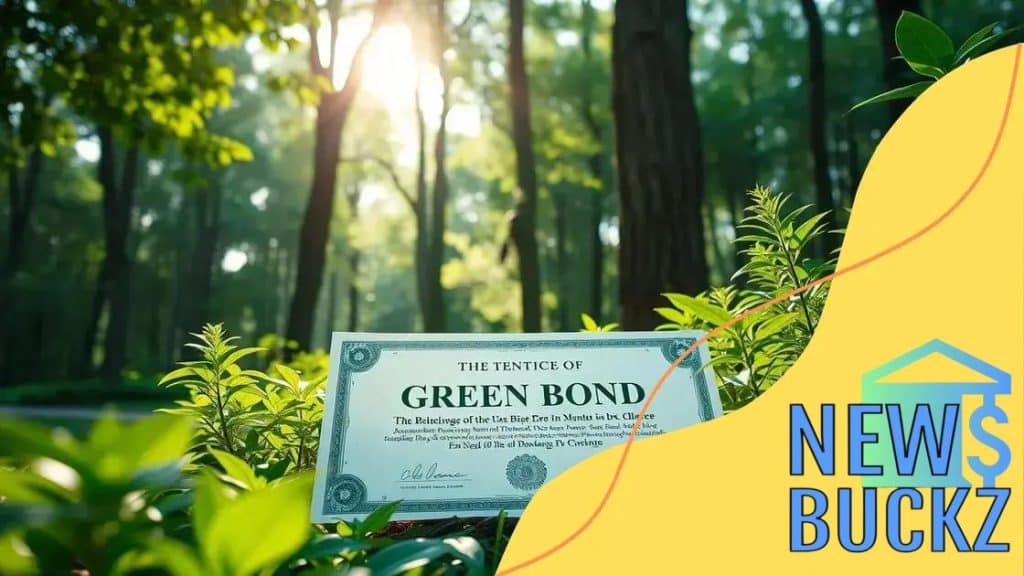How green bonds are changing the investment landscape

Anúncios
Green bonds are financial instruments designed to fund projects with positive environmental impacts, allowing investors to support sustainability while generating returns.
How green bonds are changing the investment landscape is a topic that many investors are curious about today. With a focus on sustainability and ethical investing, these bonds are reshaping financial strategies. Let’s dive into their significance and implications.
Anúncios
Understanding green bonds: what they are
Understanding green bonds is essential for investors looking to make a positive impact. Green bonds are fixed-income instruments specifically designed to fund projects that have positive environmental benefits. They provide a way for organizations to raise funds while showing a commitment to sustainability. But what exactly makes these bonds special?
What are green bonds?
Green bonds are similar to traditional bonds but are issued to finance projects that address climate change and promote sustainability. Governments, corporations, and other entities issue these bonds to gather capital for renewable energy, energy efficiency, sustainable waste management, and more. The proceeds from these bonds are strictly earmarked for environmentally friendly projects, ensuring transparency and accountability. This unique feature attracts a variety of investors interested in contributing to a greener future.
Key features of green bonds:
- Use of proceeds: The funds raised must be allocated exclusively for environmental projects.
- Reporting requirements: Issuers are expected to provide regular updates on the environmental impact of the projects funded.
- Certification standards: Many green bonds adhere to guidelines set by organizations like the Green Bond Principles (GBP) to ensure credibility.
- Market demand: The growing interest in sustainable investing has led to increased demand for green bonds.
Investors are often motivated by the desire to align their portfolios with their personal values. By choosing to invest in green bonds, they can support meaningful initiatives while potentially enjoying financial returns. The green bond market has seen significant growth, attracting both institutional and retail investors.
Anúncios
As a result, more organizations are turning to green bonds to finance projects because they not only help the environment but also open up new funding avenues. Overall, understanding green bonds, what they are, and their significance can empower investors to make informed decisions that align with their values. Their role in fostering a sustainable future is becoming increasingly vital, and more people are recognizing the benefits they offer for both the planet and their portfolios.
The rise of green bonds in investment portfolios
The rise of green bonds in investment portfolios reflects a significant shift in how investors think about sustainability and profit. As climate change concerns grow, many are seeking to make a positive impact while still achieving financial returns. Green bonds are increasingly becoming a popular choice for these socially aware investors.
Growing popularity of green bonds
The demand for green bonds has surged in recent years. Investors are eager to participate in financing projects that not only yield profits but also promote environmental sustainability. This trend is driven by several factors, including the need for climate action and the growing importance of responsible investing.
Benefits of including green bonds in portfolios
Adding green bonds to investment portfolios can provide multiple benefits:
- Diversification: Green bonds offer an opportunity to diversify investments in a growing market.
- Positive environmental impact: Funds from green bonds go directly towards projects that benefit the planet.
- Attractiveness to younger investors: Younger generations are often more environmentally conscious and prefer sustainable investments.
- Potential for stable returns: Many green bonds are issued by governments and reputable companies, providing stable returns over time.
The rise of green bonds is not just about environmental responsibility; it also represents a shift in investor behavior. Many are now focusing on how their investments align with their values. This is reshaping investment strategies across the globe, as more individuals and institutions commit to sustainable finance.
Investors are now aware that choosing green bonds can also help in managing risks associated with climate change. With traditional sectors facing stricter regulations and changing consumer preferences, green investments are seen as a hedge against future uncertainties. As the market for green bonds expands, they will likely play an even more significant role in investment portfolios. Their increasing importance reflects a broader trend towards sustainability in the finance world, ultimately leading to a more environmentally conscious investment landscape.
How green bonds contribute to sustainability
 Green bonds play a vital role in promoting sustainability. By financing projects focused on environmental improvements, they help companies and governments commit to eco-friendly practices. This connection between finance and sustainability is becoming increasingly important in today’s world.
Green bonds play a vital role in promoting sustainability. By financing projects focused on environmental improvements, they help companies and governments commit to eco-friendly practices. This connection between finance and sustainability is becoming increasingly important in today’s world.
Financing sustainable projects
Green bonds are used to fund a variety of projects that significantly benefit the environment. These can include renewable energy installations, sustainable transportation systems, and energy-efficient buildings. Each time a green bond is issued, investors are putting their money to work on initiatives that lead to a healthier planet.
Key areas of impact
The impact of green bonds extends across several key areas:
- Climate change mitigation: Funds from green bonds help reduce greenhouse gas emissions by supporting cleaner energy sources.
- Resource conservation: They promote projects that save water, energy, and other essential resources.
- Community resilience: By investing in sustainable infrastructure, communities become better equipped to handle climate-related challenges.
- Job creation: The projects funded through green bonds often create new jobs, contributing to local economies.
Investing in green bonds is not just about profits; it’s also about making a positive impact. As more investors choose to fund sustainable initiatives, we begin to see a shift in market focus. This increases awareness of environmental issues and the solutions available to combat them.
The growth of green bonds reflects a larger trend towards sustainability in investing. More people and organizations are realizing that their financial choices can lead to real change. With every green bond that is issued, we take a step forward in combating climate change and promoting a sustainable future. Their contribution to sustainability is significant, offering both financial returns and environmental benefits.
Risks and challenges of investing in green bonds
Investing in green bonds offers many benefits, but it is not without its risks and challenges. Understanding these factors is crucial for making informed investment decisions. While green bonds are intended to promote sustainability, potential investors must consider various aspects that may affect their investment outcomes.
Understanding the risks
Every investment carries some level of risk, and green bonds are no exception. Here are a few important risks to keep in mind:
- Market risk: Fluctuations in the overall market can impact bond prices, including green bonds.
- Credit risk: The issuer’s ability to repay the bond can affect returns. If a company or government faces financial difficulties, their capacity to honor their green bond obligations may be at stake.
- Regulatory changes: Changes in environmental regulations or government incentives can influence the viability of the projects funded by green bonds.
- Greenwashing: Not all green bonds are created equal. Some issuers may misrepresent their projects as environmentally friendly, leading to potential losses for investors.
While these risks exist, many investors find that the potential environmental benefits and financial returns outweigh them. It is crucial, however, to conduct thorough research before investing. Each bond’s underlying project should be evaluated to ensure its actual environmental impact matches its claims.
Challenges in the market
In addition to risks, there are several challenges associated with investing in green bonds. Some of these include:
- Lack of standardization: The green bond market lacks uniform guidelines, making it hard for investors to compare bonds effectively.
- Limited availability of options: The number of green bonds on the market is less than traditional bonds, restricting investor choices.
- Performance tracking: Investors may find it difficult to measure the long-term impact of their investments on sustainability.
- Interest rate fluctuations: Rising interest rates may lead to decreased demand for bonds, affecting their value.
Overall, while there are inherent risks and challenges in investing in green bonds, understanding these factors helps investors navigate the landscape more effectively. Engaging with credible issuers and focusing on sustainable projects can lead to informed investment decisions that align with financial goals and environmental values.
Future outlook for the green bond market
The future outlook for the green bond market appears promising as more investors and issuers recognize the importance of sustainable finance. This growing interest is leading to a more robust market that could significantly influence investment strategies. As climate change concerns escalate, the demand for green bonds is expected to increase.
Increasing demand
Many investors are now looking for ways to incorporate sustainability into their portfolios. This shift is driven partly by younger generations who prioritize environmental issues. As these investors enter the market, they bring with them a collective desire for impactful investment. This expanding demand is likely to encourage more companies and governments to issue green bonds to fund their sustainability initiatives.
Innovations in green bond offerings
The green bond market is also expected to see innovations. New financial instruments, such as sustainability-linked bonds or green loans, may emerge. These innovations can provide more options for investors and issuers alike, aligning better with evolving sustainability goals. Additionally, advances in technology can enhance the transparency and trackability of funded projects, making it easier for investors to understand the impact of their investments.
Moreover, partnerships between public and private sectors are likely to grow, amplifying efforts to address climate challenges. Many governments are setting ambitious goals for emissions reduction, which can fuel demand for financing through green bonds. By teaming up, businesses and governments can create a more favorable environment for sustainable investments.
Potential challenges ahead
Despite the positive outlook, some challenges may arise. The lack of standardized definitions for what constitutes a green bond is a significant hurdle. As the market grows, investors may face difficulties in assessing the credibility and impact of bonds. Common guidelines must be established to enhance trust and clarity.
Moreover, fluctuations in global financial markets or changes in regulatory environments could impact the green bond market. Investors must stay informed about these external factors to navigate potential risks effectively.
Overall, the green bond market is poised for growth, driven by heightened awareness and a commitment to sustainability. As investors seek environmentally responsible options, the market will likely adapt and respond to these demands, paving the way for a greener future.
FAQ – Frequently Asked Questions about Green Bonds
What are green bonds?
Green bonds are fixed-income instruments issued to fund projects with positive environmental impacts, such as renewable energy and sustainable infrastructure.
What are the main benefits of investing in green bonds?
Investing in green bonds offers financial returns while supporting sustainability, diversifying portfolios, and contributing to environmental projects.
What risks are associated with green bonds?
Risks include market fluctuations, credit risk of the issuer, and the possibility of greenwashing, where projects may not genuinely be environmentally friendly.
How is the green bond market expected to grow in the future?
The market is expected to grow with increasing demand from environmentally conscious investors and innovations in green financial instruments.





